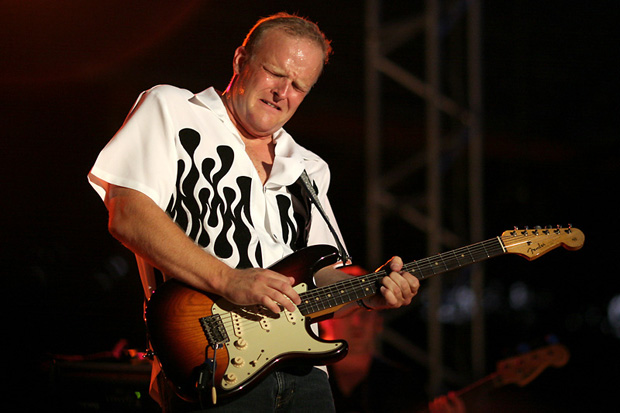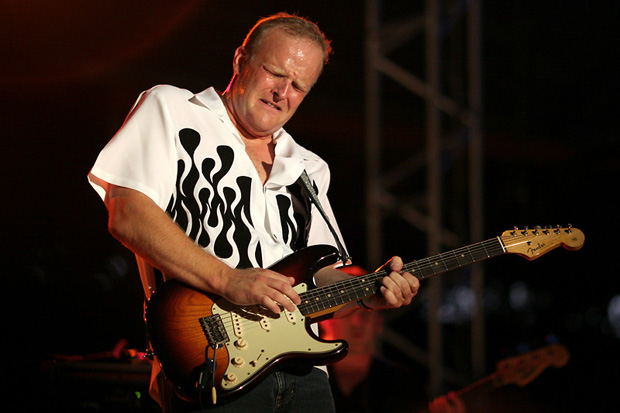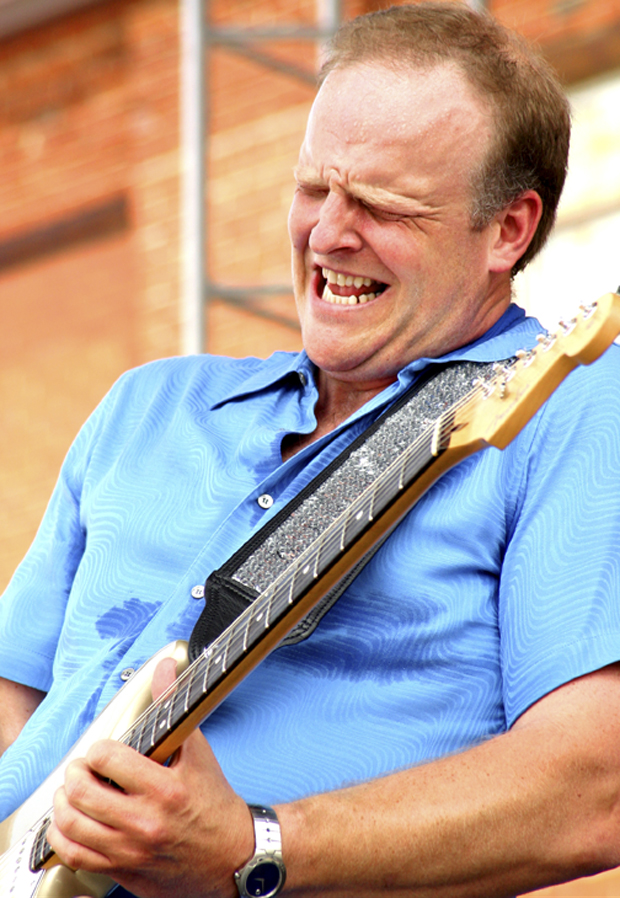Interview: 15 Questions with Blues Guitarist Albert Cummings

Massachusetts-born blues guitarist Albert Cummings released his sixth album, No Regrets (Buy on iTunes), August 28 through the Ivy Music Company. The album debuted at No. 1 in the U.S., Canada and France on the iTunes Blues Charts and at No. 5 on the Billboard blues charts.
When it comes to blues guitar, Cummings is the real deal, not to mention a talented frontman and singer. He has opened for countless legendary acts, including Johnny Winter, Sheryl Crow, B.B. King and others, and even recorded with Tommy Shannon, Chris Layton and Reese Wynans, better known as Double Trouble, Stevie Ray Vaughan's backing band.
We recently hit up Cummings with these 15 questions, covering everything from his roots, new album and what it was like to work with Double Trouble.
01. How and why did you first pick up the guitar?
My dad played guitar a bit, and there was always a guitar hanging around the house, out of its case. When it's out of its case, it's easy to just pick it up, even for just a minute. My dad's guitar was always too big for me to get my hands around the neck as a kid.
When I was 12, a friend of my father's suggested I try his five-string banjo. It was a perfect fit. The neck was small, and I took off like a rocket ship, learning all the Earl Scruggs tunes I could. As my hands started to grow, I started to mess around with the guitar.
My dad showed me the G, C and D chords, and I was hooked. Bluegrass wasn't the most popular music in those days, so with the banjo it was hard for me to find anyone to play with. I began putting a little more time into the guitar but still mostly just learning chords and progressions. I was hooked for sure, but it would still be a long time before I really dug into the guitar.
Get The Pick Newsletter
All the latest guitar news, interviews, lessons, reviews, deals and more, direct to your inbox!
02. Who were your main early influences?
I remember being in high school and not knowing who Eric Clapton was! I was into Hank Williams Jr. and Merle Haggard. Then I heard Stevie Ray Vaughan play. At first I was convinced he was a fake. How could anyone play a guitar like that? It was his album Texas Flood, and I would listen to it over and over.
I wasn't sure what I was hearing, but it was the first music that reached out and grabbed me. I began to learn more and more about Stevie as I went to college in Boston. One night I saw a bus with a Les Paul and a Stratocaster painted on the outside. I read the marquee, and it was Stevie Ray Vaughan & Double Trouble. I couldn't get any of my friends to go so I went to the show myself. Stevie came out and blew me away. I remember walking out of that show saying, "Goodbye, banjo!"
03. What was your first guitar?
It was a copy of a Gibson ES-335 that I bought at a tag sale for $13. It was a real piece of junk but it was mine. My father had an old amp and I would plug my new prized possession into that thing and crank it up every time my parents left the house. I was 14 and couldn't play anything, but it was fun pretending. The fist real guitar I bought is still the primary guitar I play today. It was a Lace Sensor Stratocaster. I was about 24, but I still wouldn't start playing or learning anything on it until I was 27.
04. Do you have a name for any of your guitars, like B.B. King's Lucille?
All of my electric guitars have names. My primary guitar is "CC," named after my wife. It's the cheapest Strat I ever bought, but it's the one I've spent the most money on. A few years back I wore out the truss rod in the neck. The Fender Custom shop made a new neck loaded with bird's eye maple for it and I love it! Fender also made me a guitar to match my primary. I call that one "Fessler," after Greg Fessler, who built it. That's my No. 2 guitar.
05. What was your journey like venturing out and becoming a professional musician, playing gigs, releasing CDs, etc.? Do you feel you've reached your goals?
I feel as though I haven't even begun yet. I've only been able to put a small percentage of my time into my music. With the release of No Regrets, I plan to change that. I have overwhelming support from people around the world. I haven't reached my overall goals, but I've reached many milestones along the way. There's nothing easy about the music business. Chris Layton from Double Trouble put it best when he said, "Life as a rock star is great for one hour a day." My journey is relatively new, but every day I learn something new and I keep pushing on. It's all about gaining fans one at a time and as long as I keep moving forward I am heading towards my goals.06. What does your new release, No Regrets, mean to you? Was it hard to balance the guitar work with finding your voice in the songs? Any favorite tracks?No Regrets is the best album I've done yet. It's the first album where I really felt comfortable in the studio. It's very hard to capture energy when that red light is on. When I first went into the studio with Double Trouble, Tommy Shannon joked that I had "red light fever." Every time they would hit the record button, I would tense up. Tommy helped me work through that.I'm really happy with the songs I wrote and how they came out. I see my albums as a photograph in time of where I am with my music. I look at it very simple. I try to write the best songs I can and I try to play my guitar the best I can when I work on my albums. The more experience I get with my music, the better my material and playing becomes. So I think No Regrets is my best to date. The focus is more about the songs.07. Tone-wise, what was your recording setup like? Amps, pedals, guitars, mics, etc.?My setup is pretty simple. A good Fender guitar plugged into a good Fender amp. I love the Fender Vibroking amp, but it's a little too raw. I put a Vibrolux with it and keep both amps at the same volume. The Vibrolux doesn't have the guts the Vibroking does, but it does have a sweeter sound, so the two complement each other perfectly. I've been pushing for Fender to make an amp that combines these two amps because it sounds so good, but so far no takers. In the studio I used this same setup for amps. For pedals I used a Goran Fatboy for my distortion. The only other pedal I used was my Dunlop Custom Audio Wah pedal. For guitars I used my Stratocasters. I used CC and Fessler mostly. They both have my signature Tele pickup on the neck, a Texas Special in the middle and a Pearly Gates on the bridge. With this pickup combination I can get almost any sound I want, all within reach of my right hand.08. Any tips you can share with musicians out there? And what do you do to warm up your voice?The main tip I would share with musicians is to be yourself because everyone else is taken. The world needs new people to bring new sounds. Don't play or sing like someone else. Just like everyone has their own voice, everyone has their own style. It bothers me to see people trying to play things like other people. I'd rather hear the original person play or sing a song than hear someone try to play it note for note. I see a lot of musicians out there that see each other as threats or competition. If you're being true to yourself, you don't have any competition. Just like you can't sound like someone else, no one can sound exactly like you. Focus on your own style and develop that to its fullest.I try to warm up my voice by singing in the green room or outside the venue. Usually my voice isn't warmed up until I'm about five songs into my set. I've never had any voice lessons, so I'm not sure what I do is right. It's the same with guitar. I had one lesson and decided it was a total waste of time. I learned to sing in basic training in Fort Knox, Kentucky. I never knew I could sing until the drill sergeants put me out in front and said, "Sing." All of my buddies encouraged me to pursue singing and eventually I did.09. Which players should guitarists study and learn their licks from?The first that comes to mind is Freddie King. He has an album called Freddie King Goes Surfing. It's all instrumentals, and it covers every rhythm you need. I spent a lot time wood shedding on that album. Of course, you have to study Stevie, but he was so far beyond good that it is frustrating to try to learn his stuff. If you look into what inspired Stevie, you can study what he studied. I always say that Stevie opened the door to the blues for me. Once you open the door, you run into Albert King, then Freddie King, then B.B. King and Jimi Hendrix, Lightnin' Hopkins, Albert Collins, Johnny Copeland, etc. The cool thing about Stevie is he could play exactly like every one of these guys, but then he could always be himself and you could plainly hear the difference.10. Here's a question from Gene in Minnesota: What type of support or lack thereof was there in your area? Was there a blues scene? Were there bars/clubs and other artists who'd help each other out?Where I live, there's no such thing as a blues club. You have to drive at least an hour to get to hear any good live music. When I finally started playing gigs I immediately went to Albany, New York, to play. I developed my following there and then was able to use that to help grow my career. When I first started playing, I got to know a small group of musicians. My experience was that musicians very rarely helped musicians. I saw too much of the ego thing, and that helped me to develop my own style even more.11. Where'd you get the idea to cover "Rock and Roll" by Led Zeppelin on your live CD?We did that song just one time at a gig before the live album. It went over really well with the crowd. On the night of the live recording, I nodded to the drummer to start "Rock and Roll" after "Blues Makes Me feel So Good" and he looked at me like, "Are you sure?" I nodded yes and off we went. I get tons of requests to do that again and sometimes we'll throw it in when it feels right. The idea didn't come from anywhere except I tend to play my sets based on what is fresh in my head. I don't use a set list. I believe if you're thinking, you're stinking. If I'm traveling to a gig and I hear a song I like, I might try it out later that night. I like being on the edge and keeping it very spontaneous. It keeps the band alert for sure!12. Any plans to cut a new live CD?With the recent release of No Regrets, I don't have any immediate plans for any new albums. I would love to do a live DVD/CD, but I'm not sure if I'll do that on the next album. We'll see how things go.13. Where do you find your inspiration for song ideas?All of my songs come from my life experiences. I try to write about what I know as much as I can. This makes it easier for me to be real about my music. Sometimes I write something out of the realm like "Checkered Flag" on "No Regrets." That's a song I wrote as if I were a NASCAR driver. I'm not sure where the idea came from as I've never driven a race car, but once I get an idea, I can usually put a song around it very quickly. At times I can go forever without having an idea. It gets very frustrating, but then I'll hear someone say something or I'll think about something and all of a sudden I have a new song.14. Was it intimidating working with Double Trouble?Imagine this. You're a beginning guitar player from a town that doesn't even know what blues is, and all of a sudden you're in Austin, Texas, with Chris Layton, Tommy Shannon and Reese Wynans looking through the glass at you while you're in a studio for the first time. Intimidating? That's an understatement! I was so scared, I couldn't even think. They kept asking me, "Who did you listen to, who do you like?" I would say, "The only thing I ever listened to is you guys." It was the first time the entire band was recording a full album with an artist since Stevie had passed away, so it even put more pressure on me in my own mind. I spent 19 days with those guys and it was the best education I could have ever received. They eventually made me feel at ease and taught me so many things that I never even knew existed. One night when I was having a hard time figuring out how I wanted to play a song, I asked Tommy, "What do you think Stevie would tell me to do?" and he said, "He'd tell you to play from the heart." I eventually named that album From the Heart. That night Tommy left for a while and came back with a wonderful surprise. He brought in pictures of Stevie before he had made it, and he brought in Stevie's hat and some candles. He set them up around me and told me to just relax and play my guitar.After the experience of working with those guys, I've always said it doesn't matter who I play with or where I play with them, I will never feel intimidated again. It was such a valuable experience! I'm so grateful for it!15. Where's the best place people can find more information about you?Visit albertcummings.com. Of course, people can find me on Facebook here.Dave Reffett is a Berklee College of Music graduate and has worked with some of the best players in rock and metal. He is an instructor at (and the head of) the Hard Rock and Heavy Metal department at The Real School of Music in the metro Boston area. He also is a master clinician and a highly-in-demand private guitar teacher. He teaches lessons in person and worldwide via Skype. As an artist and performer, he is working on some soon-to-be revealed high-profile projects with A-list players in rock and metal. In 2009, he formed the musical project Shredding The Envelope and released the critically acclaimed album The Call Of The Flames. Dave also is an official artist endorsee for companies like Seymour Duncan, Gibson, Eminence and Esoterik Guitars, which in 2011 released a Dave Reffett signature model guitar, the DR-1. Dave has worked in the past at Sanctuary Records and Virgin Records, where he promoting acts like The Rolling Stones, Janet Jackson, Korn and Meat Loaf.




“I’d always seen the guitar as a thing for really accomplished people like Jimi Hendrix – watching Nirvana on MTV Unplugged exploded my brain”: Studio nerd Corinne Bailey Rae broke through after moving on from her punk roots. Then she went back
“Elton said, ‘I'd better buy that guitar just to have in my house.’ I played it and said, ‘Yeah, you'd better buy it, so I can play it when I come by’”: One of Davey Johnstone's favorite guitars was once a piece of upscale decor for his superstar bandmate









